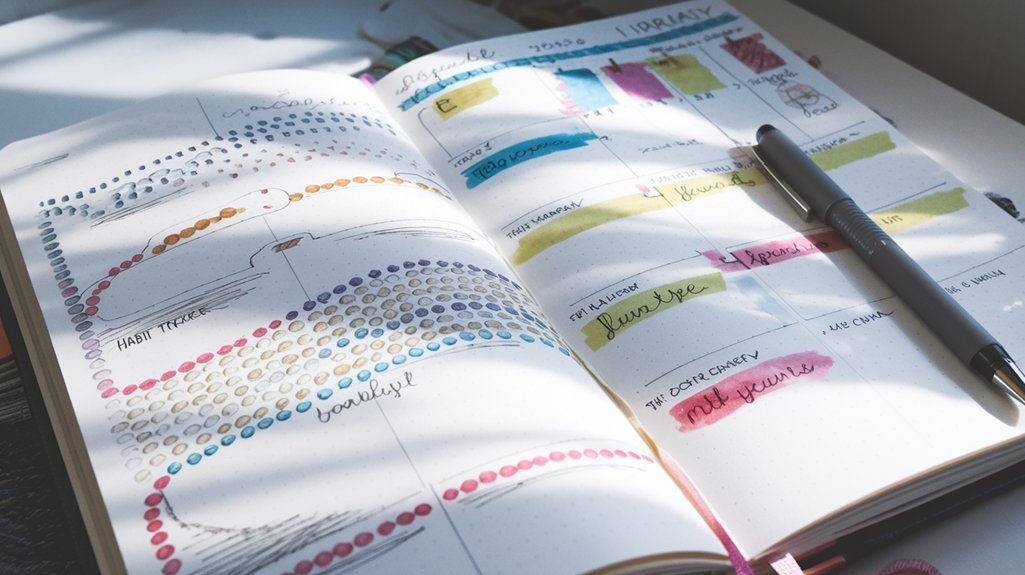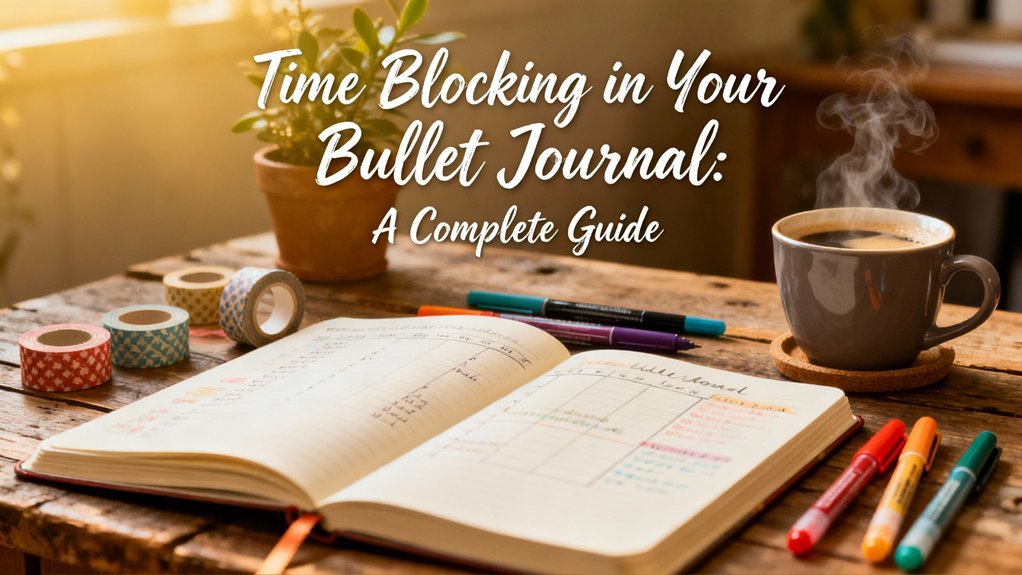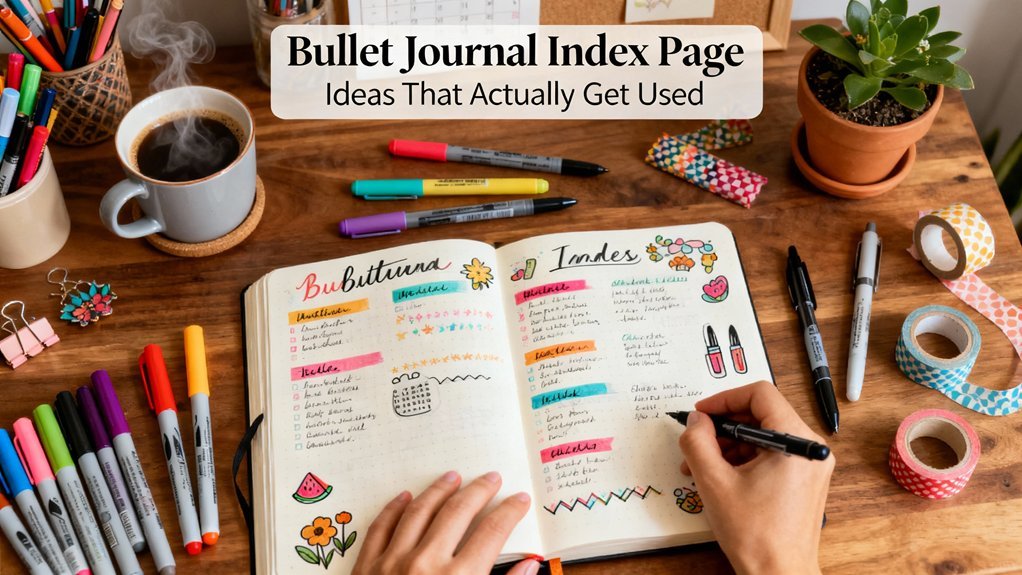Start your bullet journal with these essential collections: a Future Log to capture long-term plans, a Monthly Log for your calendar view, and a Daily Log where you'll track everything that happens today. Add a Habit Tracker to build consistency, a Brain Dump page to clear mental clutter, and a Books to Read list so recommendations don't slip away. Include a Budget Tracker for financial awareness and a Master Task List to catch everything requiring action. These foundational spreads change scattered thoughts into organized systems that actually work, and understanding how to customize each one will reveal their full potential.
Key Takeaways
- Future and Monthly Logs organize appointments and tasks, providing strategic visibility and reducing scheduling conflicts through cohesive planning.
- Daily Logs serve as central hubs using rapid logging symbols to capture tasks, events, and notes efficiently.
- Habit Trackers visualize progress through simple grids, fostering consistency and motivation by showing measurable behavioral data.
- Brain Dumps transfer mental chaos onto paper, providing clarity and emotional release while revealing hidden connections between thoughts.
- Budget Trackers establish expense categories and document spending habits, transforming journals into comprehensive financial command centers.
Future Log: Your Big-Picture Planning Page

The Future Log captures everything beyond your current month—upcoming birthdays, work deadlines, travel plans, and annual events you can't afford to miss. This foundational collection converts scattered mental notes into actionable intelligence you'll actually reference.
The Future Log transforms mental clutter into actionable intelligence—capturing every commitment beyond this month in one reliable, reference-ready system.
Future log benefits include reduced cognitive load and strategic visibility. You'll spot scheduling conflicts before they happen and allocate preparation time for major commitments. Instead of reactive scrambling, you're designing your year with intention.
Future log examples range from simple six-month grids to elaborate timeline spreads. Start with a minimalist approach: divide two facing pages into six sections, one per month. When events surface, drop them into the appropriate slot.
During monthly setup, migrate these entries to your active spreads. This forward-thinking system guarantees nothing slips through the cracks. You're not just tracking time—you're architecting it.
By helping you track the past and organize the present, the Future Log becomes a central tool for creating your future with clarity and focus. Build your Future Log first, and watch your planning evolve from chaotic to controlled.
Monthly Log: The Calendar That Actually Works for You
Your monthly log converts scattered appointments and to-dos into a cohesive view of the weeks ahead.
Start by creating a simple layout that displays your entire month at a glance—whether that's a traditional calendar grid, a vertical list, or a hybrid design that fits your planning style.
Once your structure is in place, populate it with time-sensitive events and essential tasks that anchor your month.
This foundational spread supports time management and productivity by giving you a clear visual reference that helps you allocate your energy wisely throughout the month.
Setting Up Your Layout
Creating a monthly log starts with choosing between two proven layouts: the traditional calendar grid or the minimalist list format. Your layout design should reflect how you process information—visually or linearly.
The calendar grid offers spatial awareness. You'll see your entire month at a glance, making patterns instantly recognizable. Draw a simple 7-column structure, number your days, and you're ready to plot commitments.
The list format optimizes efficiency. Write dates vertically down your page, leaving space beside each for tasks and events. This approach adapts fluidly to busy and quiet days alike.
Enhance either format with visual elements that serve purpose: color-coding for categories, symbols for recurring items, or boxes for tracking habits.
Test both layouts this month. You'll quickly discover which aligns with your workflow.
Tracking Events and Tasks
Events and tasks work differently in your brain, so capture them differently on your page. Your monthly log becomes a powerful command center when you distinguish between what's scheduled and what needs action.
Event tracking anchors your timeline, while task prioritization drives your momentum forward.
Structure your monthly spread to enhance clarity:
- Mark events with a dot – You'll feel grounded knowing exactly when commitments occur.
- Flag tasks with a dash – You'll experience control as you convert intentions into completions.
- Add priority symbols – You'll gain confidence directing energy toward what matters most.
This separation eliminates mental clutter. You're not wondering whether something requires attendance or action—you've already decided.
Your page reflects reality, and you'll move through your month with intentional precision.
Daily Log: Where the Magic Happens Each Day

Your daily log reshapes intentions into action through three powerful elements that keep you focused and productive.
Master the rapid logging symbols to capture tasks, events, and notes in seconds, then use evening reflections to track what worked and what needs adjustment.
This simplified approach guarantees you'll spend less time writing and more time accomplishing what matters most.
Essential Daily Log Components
The daily log serves as your bullet journal's heartbeat—a simple yet powerful space where you capture everything that matters in a 24-hour span.
You'll convert chaos into clarity through strategic daily tracking that adapts to your evolving needs.
Master these core elements for effective log organization:
1. Tasks with rapid logging symbols – Capture action items using bullets (•) for tasks, dashes (-) for notes, and circles (○) for events.
You'll process information faster than traditional methods.
2. Time blocks or priority markers – Flag urgent items with asterisks (*) or assign time stamps.
You're taking control of your schedule, not surrendering to it.
3. Migration indicators – Use arrows (>) for tasks moved forward and crosses (X) for completed items.
You're actively deciding what deserves your energy tomorrow.
Rapid Logging Symbol Key
Symbols convert scattered thoughts into a scannable system that works at the speed of life. You'll capture information faster than traditional journaling while maintaining clarity. The rapid logging benefits become apparent immediately—you're processing decisions, tracking progress, and managing chaos with minimal friction.
Effective symbol usage alters your daily log into a command center. Here's your core symbol key:
| Symbol | Meaning |
|---|---|
| • | Task |
| × | Completed task |
| > | Migrated task |
| ○ | Event |
| — | Note |
Start with these five symbols. You'll build muscle memory within days, making entries instantaneous. Add custom symbols only when you've mastered the basics. This discipline keeps your system lean and actionable, preventing the symbol overload that derails beginners.
Evening Reflection Practice Tips
Capturing tasks throughout the day means nothing if you never close the loop. Your evening reflection practice converts scattered activities into meaningful progress.
Develop an evening mindset that views each day as data worth analyzing. Set aside five minutes before bed to review your daily log using reflection prompts that drive clarity:
- What moved forward today? Celebrate completed tasks and acknowledge your momentum.
- What's blocking progress? Identify obstacles preventing task completion and strategize solutions.
- What deserves tomorrow's focus? Migrate essential tasks forward and eliminate what no longer serves your goals.
This nightly ritual isn't busywork—it's your innovation engine. You'll spot patterns, refine systems, and make intentional choices rather than reactive ones.
Your bullet journal becomes a living feedback loop that evolves with you.
Habit Tracker: Building Consistency One Check Mark at a Time
Building new habits becomes measurably easier when you track them visually in your bullet journal. You'll convert abstract intentions into concrete data points that reveal your progress patterns and motivate continued action.
Design your tracker to monitor five to seven habits simultaneously. Create a simple grid with habits listed vertically and dates horizontally. Each check mark represents completion, building a visual chain you'll want to maintain. This consistency technique utilizes the psychological power of visible progress.
Focus on keystone habits that trigger positive cascades in other areas. Exercise, meditation, or reading for thirty minutes daily become non-negotiable when you're tracking them. You'll quickly identify obstacles preventing consistency and adjust your approach accordingly.
Habit formation accelerates when you review your tracker weekly. Analyze patterns, celebrate streaks, and troubleshoot gaps without judgment. Your bullet journal becomes a laboratory for testing new behaviors and optimizing existing routines.
Track deliberately, adjust strategically, and watch sustainable habits emerge.
Brain Dump: Your Mental Clutter Collection Page
Your mind wasn't designed to hold every thought, task, and worry simultaneously—that's where brain dumping comes in.
This powerful collection technique lets you transfer mental chaos onto paper, creating space for clarity and focused action.
You'll discover what brain dumping actually does, how to structure your dedicated page, and when to use this tool for maximum mental relief.
What Is Brain Dumping
When thoughts swirl endlessly in your mind like a mental whirlwind, brain dumping offers immediate relief. This technique converts mental chaos into organized clarity by transferring every thought onto paper without judgment or structure.
Brain dump benefits include:
- Liberation from mental overload – Feel the weight lift as racing thoughts finally escape your crowded mind.
- Breakthrough moments – Discover hidden connections between ideas you didn't know existed.
- Emotional release – Experience genuine calm when worries, tasks, and dreams find their rightful place on paper.
You're not organizing yet—just capturing everything. This creative brainstorming foundation lets you process information later with fresh perspective.
Set a timer for ten minutes and write continuously. No filtering, no editing. Convert invisible mental clutter into visible, manageable content you'll actually address.
Setting Up Your Page
The brain dump page requires nothing more than blank space and a bold title at the top.
You don't need to worry about page aesthetics or designing headers with elaborate embellishments. Keep it minimalist and functional.
Write “Brain Dump” across the top in your clearest handwriting, then fill the rest with lines or leave it completely open for freeform writing.
This collection thrives on simplicity. You're creating a catchall space where thoughts can land without judgment or organization.
Draw a simple border if you want visual boundaries, but resist the urge to overcomplicate. The power lies in its accessibility—when your mind races, you'll capture those thoughts immediately rather than spending time perfecting layouts.
Your brain dump changes mental chaos into documented clarity.
Best Times to Dump
Now that your page stands ready for action, strategic timing amplifies its effectiveness. You'll access maximum brain benefits when you schedule your dumps intentionally. The best times reshape this practice from random scribbling into a powerful mental reset tool.
Optimal Dump Windows:
- Sunday evening – Capture the week ahead before anxiety spirals into Sunday scaries.
- Mid-week surge – Wednesday's chaos demands a clarity intervention when tasks multiply.
- Month-end shift – Process accumulated mental debris before fresh calendar pages arrive.
You're not waiting for overwhelm to strike. You're proactively clearing cognitive space. Each scheduled dump prevents thought congestion before it paralyzes your productivity.
Set phone reminders. Block calendar time. Treat these sessions as non-negotiable appointments with your clarity. Your future self will thank your present discipline.
Gratitude Log: Training Your Brain to See the Good
Research shows that regularly recording what you're grateful for rewires your brain to naturally spot positive experiences throughout your day. Your gratitude log alters abstract appreciation into concrete data you can track and enhance.
Start simple: dedicate one page per week where you'll list three things daily. Use gratitude prompts like “What made me smile today?” or “Who added value to my life?” to jumpstart your practice when inspiration stalls.
Dedicate one page weekly to log three daily gratitudes using prompts like “What made me smile?” when inspiration runs dry.
Level up by pairing entries with positive affirmations that reinforce your mindset shifts. Write “I attract abundance” alongside notes about unexpected opportunities, or “I build meaningful connections” when logging quality interactions.
Track patterns in your entries. You'll discover what consistently fuels your happiness—whether that's creative projects, nature exposure, or specific relationships.
This intelligence lets you design more joy into your routine by prioritizing what actually matters. Your gratitude log becomes a strategic tool for designing a fulfilling life.
Books to Read: Never Forget Another Recommendation

How many brilliant book recommendations have vanished from your memory within hours of receiving them? Your bullet journal converts scattered suggestions into an actionable reading system.
Create a dedicated Books to Read collection that captures recommendations, favorite authors, and literary quotes before they disappear.
Structure your collection to support your reading goals:
- Track discoveries that ignite curiosity – Log book titles with who recommended them, specific book genres that excite you, and why each story matters to you personally.
- Design reading challenges that push boundaries – Set seasonal reading targets, explore unfamiliar genres, or commit to book clubs that expand your perspective.
- Celebrate completed journeys – Record finishing dates, write honest book reviews, and extract powerful quotes that resonate with your innovation mindset.
This collection becomes your literary compass, guiding you toward enlightening reads while honoring every recommendation. You'll never lose another book suggestion again.
Budget Tracker: Getting Your Finances Under Control
While tracking books enriches your mind, tracking money secures your future. Your bullet journal evolves into a powerful financial command center when you create a budget tracker that aligns with your financial goals.
Start by establishing expense categories that reflect your lifestyle. Document income tracking alongside your spending habits to identify patterns you've been missing. Choose from proven budgeting methods like the 50/30/20 rule or zero-based budgeting—whatever drives your financial milestones forward.
Track income, categorize expenses, and choose a budgeting method that propels you toward your financial milestones with clarity and purpose.
Design spreads that showcase your savings strategies and debt management progress. You'll see exactly where your money flows each month, enabling data-driven decisions that accelerate your wealth-building journey.
Create visual indicators for bill due dates, savings targets, and debt payoff timelines. This tangible approach keeps your finances visible and actionable, eliminating the “out of sight, out of mind” trap that derails most financial plans.
Your future self will thank you for this innovation.
Goal Setting Pages: Turning Dreams Into Action Plans

Your goals deserve more than wishful thinking—they need a concrete roadmap. Goal setting pages convert abstract ambitions into tangible action milestones through strategic planning and dream visualization.
Structure your pages to bridge the gap between aspiration and achievement:
- Break down big dreams into quarterly targets that feel challenging yet attainable, creating momentum through visible progress.
- Map specific action milestones with deadlines that hold you accountable and prevent procrastination from stealing your potential.
- Track obstacles and solutions to build resilience and adaptability when challenges inevitably arise.
Your bullet journal becomes your innovation lab where you experiment with different goal frameworks. Try the SMART method, reverse engineering from your ideal future, or habit stacking to compound small wins.
Review your progress weekly, adjusting strategies based on real data rather than assumptions. You're not just documenting goals—you're architecting the life you've envisioned through deliberate action.
Master Task List: The Collection That Keeps Nothing Forgotten
Goals illuminate where you're headed, but without a reliable system to capture every task along the way, important actions slip through the cracks. Your Master Task List becomes your cognitive safety net—a centralized collection where you dump everything requiring action.
Create dedicated sections for different life areas: work projects, personal commitments, household maintenance, and creative pursuits. This structure converts overwhelming mental clutter into organized, actionable items.
Implement task prioritization strategies by marking entries with symbols: stars for urgent tasks, dots for standard items, and arrows for delegated work. You'll instantly recognize what demands immediate attention versus what can wait.
Integrate effective reminder techniques by color-coding time-sensitive tasks or adding deadline annotations. Review this collection weekly, migrating active tasks to your daily logs while keeping completed items visible as progress markers.
This isn't just list-making—it's building an external brain that guarantees nothing important gets forgotten.
Frequently Asked Questions
What Supplies Do I Need to Start a Bullet Journal?
You'll need minimal essential supplies to launch your bullet journal journey. Start with a quality notebook—dotted pages work best—and a reliable pen you love writing with. That's it! You're ready to begin.
Want to improve your setup? Add colored pens for coding tasks, a ruler for clean lines, and highlighters for emphasis.
Don't overthink it—your bullet journal evolves with you. Grab your essentials and start experimenting today. The perfect system emerges through action, not preparation.
How Do I Fix Mistakes in My Bullet Journal?
Like jazz musicians who change wrong notes into improvisation, you'll master mistake correction in your bullet journal through creative solutions.
Embrace white-out tape for clean erasure, or turn errors into decorative elements with washi tape and stickers. You can draw boxes around mistakes, converting them into design features.
Cross out errors with a single line—it’s perfectly acceptable and shows your journal's authentic journey. Remember, imperfections aren't failures; they're opportunities to innovate your spreads.
Should I Use a Dotted, Lined, or Blank Notebook?
Choose a dotted notebook—it's the innovation sweet spot you're looking for.
Dotted notebook benefits include flexible layouts and clean lines without visual clutter. While lined notebook pros offer structure for neat writing, they'll limit your creative freedom.
Dots give you subtle guidance for straight text while enabling custom spreads, drawings, and trackers. You'll release endless possibilities without feeling constrained.
Start with dots and revolutionize how you organize your life with maximum versatility and minimal restriction.
How Much Time Does Bullet Journaling Take Each Day?
You'll spend just 5-10 minutes on daily time once you're rolling.
The initial setup takes longer—maybe 30-60 minutes to create your index, future log, and monthly spread.
After that, it's quick morning or evening check-ins to log tasks and migrate items.
You're building a personalized productivity system, not maintaining a time-consuming hobby.
Start minimal, then expand collections as you discover what drives your workflow forward.
Can I Start Bullet Journaling Mid-Year or Mid-Month?
You can start anytime—mid-year, mid-month, or mid-week. There's no perfect moment except now.
Starting fresh releases bullet journal benefits like clarity, productivity, and intentional living. Mid year motivation comes from breaking free of traditional calendar constraints and designing systems that work for *you*.
Don't wait for January 1st to change your life. Grab your notebook today, create your first spread, and begin tracking what matters.
Your journey starts when you decide it does.
Conclusion
You've spent years letting random notebooks, sticky notes, and phone apps scatter your life across a dozen places. Now you're discovering that one simple journal can actually hold it all together. Ironic, isn't it? The analog solution works better than the digital chaos. Stop overthinking which collections to start with—grab your notebook and launch your future log today. You'll organize your entire life with nothing more than paper, a pen, and consistent action.













